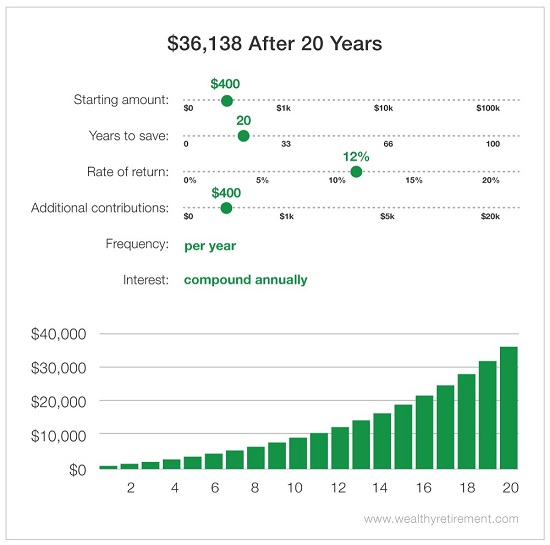Saving a little extra for retirement almost always requires some sacrifice. But I’ve found a way to build your retirement fund using money that you’ll never miss.
Better yet, the IRS can’t touch it.
[ad#Google Adsense 336×280-IA]And once you set it up, accumulating this extra retirement savings will require virtually no work. All you have to do is dump your credit card rewards into an investment account.
It should be an attractive prospect for most folks. The average American has 3.4 credit cards.
And if you like to use your card to pay your daily or monthly expenses, there is probably a rewards program tied to it.
Credit card rewards programs come in all shapes and sizes.
Some offer miles or points redeemable for merchandise, airline tickets or hotel nights. Others offer “cash back” in the form of gift cards.
Astonishingly, nearly one-third of cardholders aren’t redeeming their rewards. The reason? They forget they have them or they take too long to accumulate. Sometimes the points simply expire.
It’s a costly oversight. Because that unclaimed money could be working for America’s retirement funds.
Put Your Retirement Rewards on Autopay
Keep in mind that not all credit cards offer rewards. If you are unsure if yours does, contact your credit card company and request a copy of the terms and conditions of your card.
A few cards allow you to deposit your monthly rewards earnings directly into a Roth or regular IRA, a taxable investment account or even a 529 savings plan.
For example, the Fidelity Rewards Visa Signature Card may be linked to a Fidelity brokerage account, 529 savings plan, retirement account or even a charitable giving account. And the Upromise MasterCard issued by Barclays allows you to contribute your rewards to a 529 savings plan or pay down eligible student loans.
Offered by just a handful of brokerages, these wealth-building retirement rewards cards pay 1% to 2% cash back for your retirement account. And some of them charge no annual fee to carry them.
As an added bonus, Uncle Sam classifies most all credit card rewards, including cash back, as rebates.
This means the IRS won’t tax them.
So the entire amount is available to invest and grow through the power of compounding.
For someone like me, those retirement points can really add up. I pay as many expenses as I can on one credit card. Then, I pay off the entire balance each month.
Last year, my spending earned me $400 in cash back. But if my rewards were linked to an IRA, I could have put that $400 to work using Marc’s 10-11-12 System.
Marc’s 10-11-12 System is designed to generate 11% yields or 12% average annual total returns over a 10-year period.
Assuming my spending and rewards stay the same, using this system, I can drop another $400 a year into my account.
In just 10 years, my retirement rewards will be worth more than $9,100 – more than double the face value of a cash-back gift card.

And in 20 years, its value will grow to more than $36,000!

As my example shows, when it comes to saving for retirement, a little bit goes a long way.
Responsible Cardholders Need Only Apply
If you decide an investment rewards program is the right savings strategy for you, be sure to compare cards before you apply. Find out exactly how much cash you’ll earn with each card and if there are any restrictions. You’ll also need to take a look at the annual fee. If there is one, your annual rewards must be greater to justify paying it.
And like any credit card, you’ll want to check out the annual percentage rate (APR). You’ll pay that interest rate if you ever carry a balance.
Speaking of credit card balances, this retirement savings strategy won’t work if you carry one. In fact, since the APR is higher than the cash-back reward percentage, it will do the opposite – it’ll cost you.
You’ll also need to open an IRA or other investment account linked to the card. Some firms enforce minimum account balances such as $2,500. So you’ll have to fund the account from external sources before you start racking up those retirement rewards.
Of course, there’s a chance the market will head south, and the value of your rewards investments could take a short-term dip. But since you never had the rewards money in the first place, you won’t notice.
To be clear, this is a supplemental strategy. You shouldn’t expect investing your credit card rewards to make you rich. And it isn’t a replacement for your retirement savings strategy. It’s just a simple, passive way to add some oomph to your nest egg.
So take “charge” of your retirement. Don’t waste your credit card rewards. Invest them and watch them grow!
Good investing,
Kristin
[ad#agora]
Source: Wealthy Retirement
